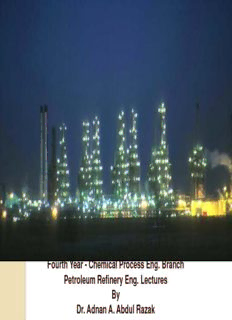
Chemical Process Eng. Branch Petroleum Refinery Eng. Lectures By Dr. Adnan A. Abdul Razak PDF
Preview Chemical Process Eng. Branch Petroleum Refinery Eng. Lectures By Dr. Adnan A. Abdul Razak
Fourth Year - Chemical Process Eng. Branch Petroleum Refinery Eng. Lectures By Dr. Adnan A. Abdul Razak Petroleum Processing Overview Petroleum Processing Overview Actually, crude oil straight from the ground has some value, but not a lot. Table 1 shows the history of petroleum before 1861. Before 1859, oil that was mined or that simply seeped up out of the ground was used to water-proof ships, as an adhesive in construction, for flaming projectiles, and in a wide variety of ointments. After 1859, petroleum became more and more important to the world’s economy, so important that today, without a steady flow of oil. It provides fuels and lubricants for our trucks, trains, airplanes, and automobiles. Ships are powered by fuel oil derived from petroleum. Bottom-of-the-barrel petroleum derivatives pave our roads and provide coke for the steel industry. Petroleum Processing Overview At the end of 2003, the world was consuming 78 million barrels of oil per day. In August 2005, that volume of petroleum was worth $4.6 billion per day, or $1.7 trillion per year. The availability of kerosene got a sudden boost on August 27, 1859, when Edwin L. Drake struck oil with the well he was drilling near Titusville, Pennsylvania. History of Petroleum Processing Modern Petroleum Processing All refineries are different. Oil refining separates everything into useful substances. The petroleum refining industry converts crude oil into more than 2500 refined products, including liquefied petroleum gas, gasoline, kerosene, aviation fuel, diesel fuel, fuel oil, lubricating oil and petrochemical industry feedstock. Most refineries perform the seven basic operations named Petroleum Refinery Feed-Stocks and Products
Description: